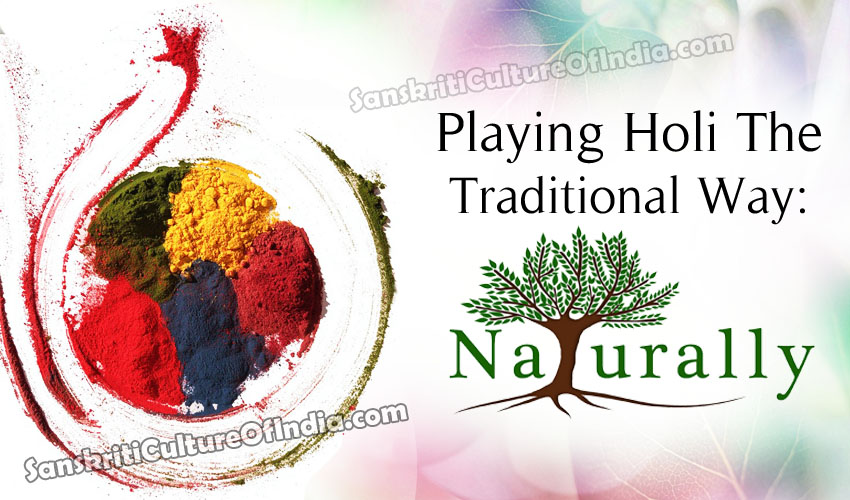Harmful chemical colors are the perils of Holi. Have you ever wondered how to make the festival of colors natural and healthy for our environment and ourselves? Did you know that Holi can be fun and harmless if you play with environment-friendly natural colors. These are not only cheap but can also be made easily at home.
Our World of Colors
Explore the fascinating world of natural colors. Experiment with different flowers, fruits and vegetables (like black grapes, dried fruits of amla/gooseberry), leaves (eucalyptus), plants (arandi/castor). Encourage the use of eco-friendly natural colors and motivate our friends to do so.
Learn How to Make Natural Holi Colors at Home
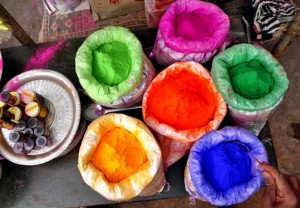 Save Your Skin from Chemical Colors
Save Your Skin from Chemical Colors
Most Holi colors sold in the market are oxidized metals or industrial dyes mixed with engine oil. Sample this: Green comes from copper sulphate, purple is chromium iodide, silver is aluminum bromide, black is lead oxide and shiny colors are result of powdered glass being added to the colors. All these are toxic and can result in anything from skin allergies, eye irritation, blindness and much more. When washed, they enter the rivers and the soil and increase pollution.
Chemical Colors, Compositions and Health Effects
- Lead Oxide (Black): Renal failure, learning disability
- Copper Sulphate (Green): Eye allergy, temporary blindness
- Chromium Iodide (Purple): Bronchial asthma, allergies
- Aluminium Bromide (Silver): Carcinogenic
- Mercury Sulphite (Red): Skin cancer, minamata
Play Holi the Vedic Way
By using safe, natural colors we not only save our skins but also help save our environment and conserve our biodiversity. When these colors percolate into the soil and water they do not add toxicity to our blue planet, and cause no harm to the myriad life forms that live in the soil and water. Thereby, we also popularize the diverse plants and trees that give us these colors, and live life the Vedic way, our ancient and most precious heritage.
Here’re all the recipes that’ll make your Holi naturally colorful! Learn how to get reds, greens, blues, saffrons, yellows and magentas from fruits, vegetables, flowers and cereals… all at home.
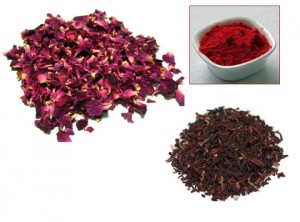 Ravishing Reds
Ravishing Reds
Dry: Red Sandalwood Powder / Raktachandan / Lalchandan (Pterocarpus santalinus) has a beautiful red color, which is beneficial for the skin and is used for face packs, etc. This can be used instead of Red gulal. Dry red hibiscus flowers in the shade and powder it to make a lovely red color. To increase the bulk add any flour to it, in proportion to the vibrancy of the color you want to obtain. Sinduria (Annato) has a water chestnut shaped fruit, which contains lovely brick color red seeds. These yield both dry and wet colors.
Wet: Put two teaspoons of Red Sandalwood powder in five litres of water and boil. Dilute with 20 litres of water. Peels of Red Pomegranate boiled in water give red.
Mix a pinch of lime powder (the one that we eat with our paan / betel leaves) in half a cup of water and add 2 table spoon of haldi (turmeric) powder in it. Mix it thoroughly. Use only after diluting with 10 litres of water.
Buras (Rhododentron arboreum) known as Burans in the Garhwal hills and Brand in the Kumaon hills of India gives a lovely red color when soaked in water overnight. The Palita Madar / Pangri / Indian Coral tree (Erythrina indica), found commonly in coastal regions, has large red flowers. Soak the flowers in water overnight.
Boil wood of Madder Tree in water for a deep red. Red color can also be obtained from juice of tomatoes and carrots. This can be diluted with sufficient quantity of water to remove the stickiness.
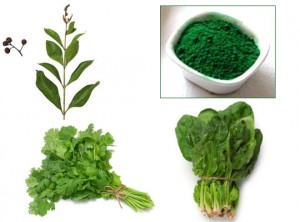 Garden Greens
Garden Greens
Dry: Use mehendi / henna powder (not mixed with amla) separately or mix with equal quantity of any flour to attain a lovely green shade. Dry mehendi will not leave color on your face as it can be easily brushed off. Only mehendi mixed in water might leave a slight color on your face. Many people like smearing other person’s hair with colors. How about doing it with mehendi powder and saving a trip to the parlor? Dry and finely powder the leaves of Gulmohur tree for a green. Crush the tender leaves of the Wheat plant to obtain a natural safe green Holi color.
Wet: Mix two teaspoons of mehendi in one litre of water. Stir well. Green color can also be obtained by mixing a fine paste of leaves like spinach / palak, coriander / dhaniya,mint / pudina, etc. in water.
Marvellous Magentas
Wet: Slice or grate one Beet root. Soak in 1 litre of water for a wonderful magenta. Leave overnight for a deeper shade. Dilute with water. Boil the peels of 10-15 onions in half litre of water for an orangish-pink color. Remove the peels before using to remove the smell.
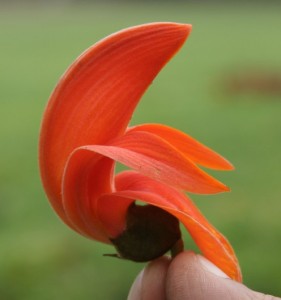 Sparkling Saffrons
Sparkling Saffrons
Wet: The Flame of the Forest (Butea monosperma), known as Tesu, Palash or Dhak in Indian languages, is the source of the wonderful, traditional color for Holi. The flowers are soaked overnight in water and can also be boiled to obtain a fragrant yellowish orange colored water. Legends say Lord Krishna used to play Holi with Tesu flowers, which also have some medicinal properties. Boil flowers petals of Semul / Silk Cotton, a red variety of Bombax ceiba) in water. Both Tesu and Semul bloom during February-March.
Collect and dry the stalks of Harashringar / Parijatak (Nyctanthes arbontristis) flowers during the early winter season. Soak them in water to get a pleasant orange color.
Mix a pinch of sandalwood powder in 1 litre of water for an instant, beautiful and fragrant saffron color.
Soak a few stalks of Saffron / Kesar in 2 table spoons of water. Leave for few hours and grind to make a fine paste. Dilute with water for desired color strength. Though expensive, it is excellent for the skin.
Dazzling Yellows
Dry: Mix two teaspoons of haldi / turmeric powder with double the quantity of besan (gram flour). Haldi and besan are extremely healthy for our skin, and are also used widely as a ubtan while taking bath. You can use the ordinary haldi or “kasturi” haldi which is very fragrant and has enhanced therapeutic effects. Besan can be substituted by wheat / rice / arrowroot flour or talcum powder.
Flowers like Amaltas (Cassia fistula), Marigold / Gainda (Tagetus erecta), and Yellow Chrysanthemums yield different shades of yellow. Dry the petals of these floweres in shade and crush them to obtain a fine powder. Take appropriate quantity of the powder and mix it with besan or use separately.
Dry the rind of the Bael fruit (Aegle marmelos) and grind to obtain a yellow colored powder.
Wet: Add one teaspoon of haldi to two litres of water and stir well. This can be boiled to increase the concentration of color and further diluted. Soak 50 marigold flowers in 2 litres of water. Boil and leave overnight.
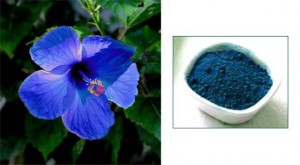 Bright Blues
Bright Blues
Dry: Jacaranda flowers can be dried in the shade and ground to obtain a beautiful blue powder. The flowers bloom in summers. The blue Hibiscus (found in Kerala) can be dried and powdered.
Wet: Crush berries of the Indigo tree and add to water for desired color strength. In some Indigo species the leaves when boiled in water yield a rich blue.
~ Subhamoy Das

